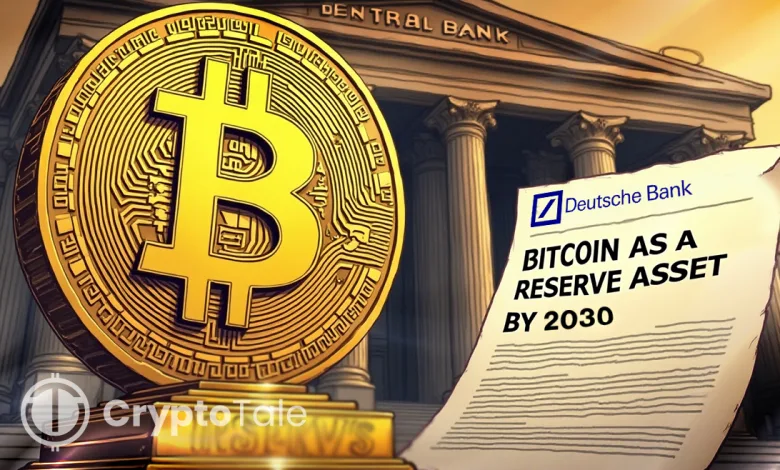Bitcoin May Join Central Bank Reserves by 2030: Deutsche Bank

- Deutsche Bank predicts Bitcoin could become a reserve asset for central banks by 2030.
- Bitcoin’s reduced volatility and growing legitimacy mirror gold as a store of value.
- Corporate adoption and regulatory clarity boost BTC’s potential for central bank inclusion.
Deutsche Bank predicts that Bitcoin may become a reserve asset for central banks by 2030, potentially joining gold on balance sheets. The bank’s analysis highlights Bitcoin’s growing legitimacy, reduced volatility, and role as a hedge against inflation and geopolitical risks. This shift reflects a broader recognition of Bitcoin as a stable store of value, similar to gold.
Bitcoin’s price recently surged above $126,000, marking a new record. This increase, paired with reduced volatility, has made the digital currency more appealing as an alternative reserve asset. According to Deutsche Bank analysts Marion Laboure and Camilla Siazon, Bitcoin’s behavior now mirrors gold, an asset long valued for its stability and scarce supply.
Corporate Adoption Strengthens Bitcoin’s Reserve Asset Potential
The analysts reveal that Bitcoin may be a foundation of financial security, just as it was gold in the 20th century. They project that, by the year 2030, central banks will include Bitcoin as a reserve currency. Their discussion outlines the possibility of Bitcoin being a legitimate strategic tool, which could be a source of financial security by diversification, particularly when the price remains steady.
Gold continues to rise in value due to central banks’ efforts to hedge against inflation and political risks, especially in the U.S. Bitcoin, in turn, has become an attractive alternative as it is not tied to any national currency or government. With its fixed supply and increasing demand, Bitcoin is positioned as a global store of value, much like gold.
Bitcoin’s appeal has also grown among corporations. Many companies have created Bitcoin treasuries, holding the asset on their balance sheets as a store of value. This corporate adoption strengthens Bitcoin’s position as a legitimate reserve asset. The increased liquidity and growing investor confidence further boost its potential for central bank inclusion. The changes in the price of Bitcoin have been reduced, hence it is less risky as an asset despite its volatility-related concerns.
Related: Ken Griffin Warns as Gold and Bitcoin Challenge Dollar Power
Bitcoin’s Challenges and Path to Broader Acceptance as a Reserve Asset
Nonetheless, Bitcoin has limitations because of the non-underlying support. Bitcoin is not anchored on physical objects and cash flows as conventional assets. It is simply digital code, and this casts doubts on whether it could be held as a long-lasting reserve asset.
The increase in the legitimacy of Bitcoin is also due to the emergence of more analytical regulatory frameworks. With the governments and financial institutions providing policies on digital assets, Bitcoin acceptance is therefore likely to be widened.
The trend of Bitcoin is forecasted by Deutsche Bank to parallel that of gold, which increases its scepticism and acceptance with time. As regulation advances and the globe depends more on other reserve assets, Bitcoin would form a significant part of central bank portfolios.
The increase in the presence of Bitcoin in the national financial system is an indicator of the change in perspective of the central banks with regard to digital currencies. The adoption of Bitcoin as a reserve asset may be hastened as the U.S. and other countries implement it.
The projection of Deutsche Bank reveals the opportunity of Bitcoin as a reserve asset. With its increasing liquidity and intensifying regulatory framework, the position of Bitcoin next to gold in central bank reserves is more probable. The future progress of Bitcoin as an inflation and geopolitical risk hedge would help it secure a place in sovereign portfolios by 2030.





